A well-organized kitchen makes cooking easier and less stressful. When everything is in its place, cooking becomes a joy. This guide will help you organize your kitchen, from decluttering to finding smart storage solutions.
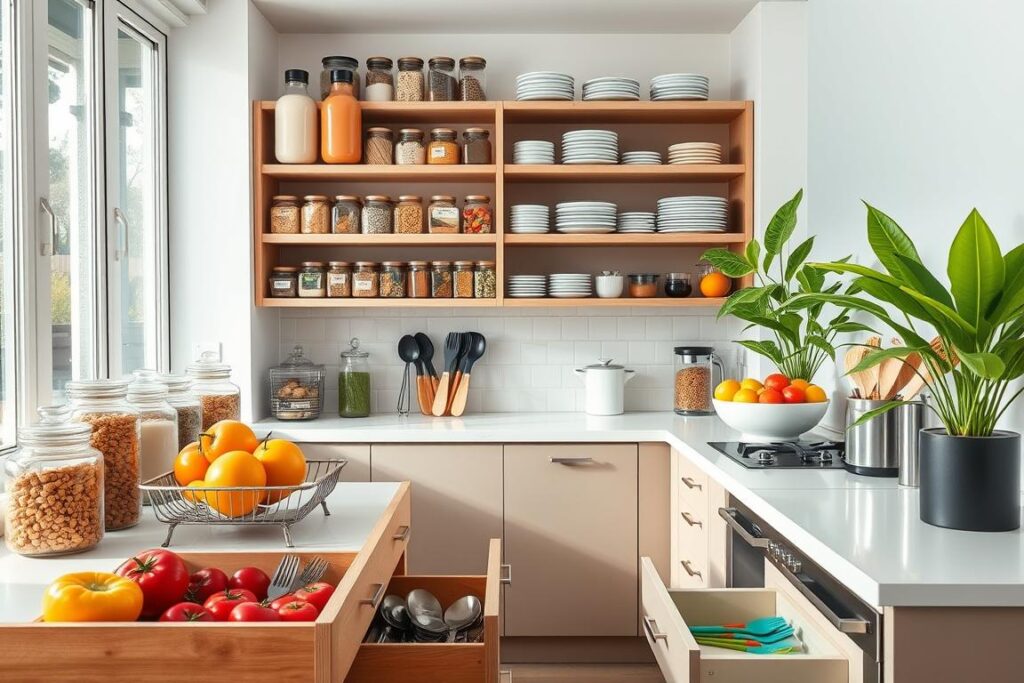
You’ll learn to evaluate your kitchen, spot clutter, and plan your organization. We’ll talk about the need to declutter, set up zones for tasks, and use space wisely. By the end, you’ll know how to make your kitchen a tidy and efficient space.
Key Takeaways:
- Assess your current kitchen setup and identify clutter zones
- Declutter and purge unnecessary items to free up space
- Create a kitchen organization plan with designated zones
- Invest in versatile storage solutions to maximize space
- Implement a maintenance routine to keep your kitchen organized
Assess Your Current Kitchen Organization
Before starting a kitchen organization project, take a moment to look at your current setup. This step helps you see what needs work and plan for your dream kitchen pantry organization.
Take Inventory of Your Kitchen Items
Begin by making a detailed list of all your kitchen items. This will show you what you have, help you find duplicates, and spot things you don’t need anymore. Just grab a pen and paper, and follow these steps:
- Check each cabinet, drawer, and shelf, listing every item you find.
- Group similar items together by category (like baking supplies, spices, and canned goods).
- Mark any duplicates or items you haven’t used in a year.
As you list your items, think about whether each one is really needed in your kitchen. Marie Kondo, a famous organizer, advises:
Keep only things that make you happy. Then, get rid of the rest.
Identify Problem Areas and Clutter Zones
While making your list, notice any areas in your kitchen that seem messy or disorganized. These trouble spots might include:
- Drawers full of utensils and gadgets
- Countertops that are too cluttered for cooking
- Pantry shelves that are too full to find what you need
Spotting these clutter zones helps you focus your efforts. You can make a plan to organize your pantry with clear bins and other storage. Fixing these areas will greatly improve your kitchen’s look and function.
Declutter and Purge Unnecessary Items
To organize your kitchen well, start by getting rid of things you don’t need. Look at your kitchen and find items you don’t use anymore. Get rid of duplicates, broken things, and gadgets you hardly use.
Start by emptying your cabinets, drawers, and pantry. Go through each item and ask yourself:
- When was the last time I used this?
- Do I have multiple items that serve the same purpose?
- Is this item in good condition and fully functional?
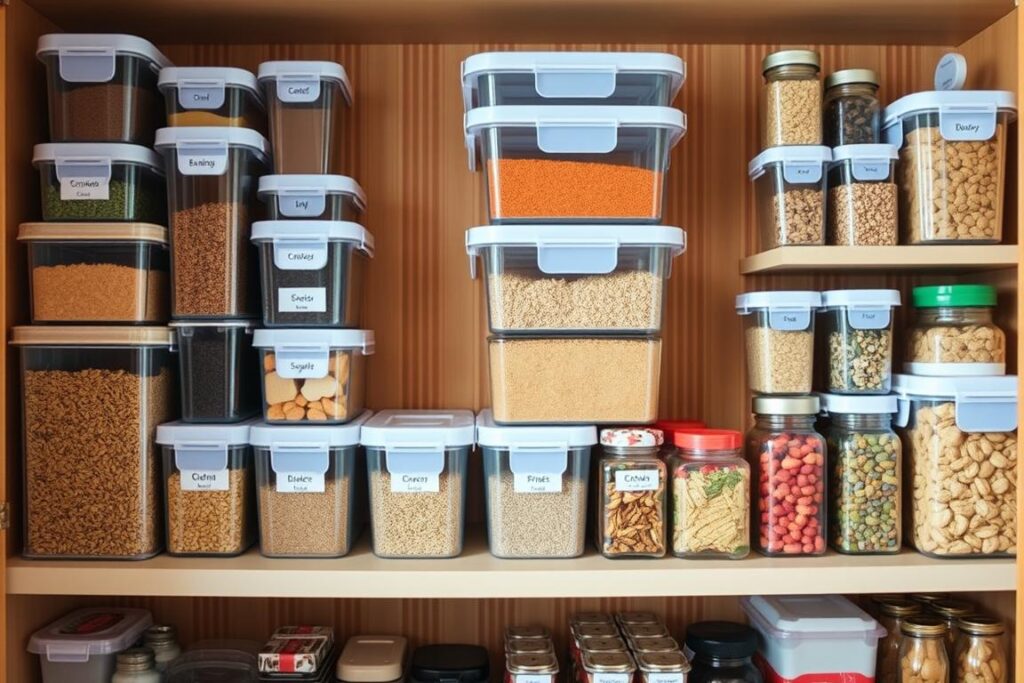
While sorting, think about getting pantry stackable storage and kitchen pantry containers. These can help you use your space better and keep things tidy.
“The first step in crafting the life you want is to get rid of everything you don’t.” – Joshua Becker
After picking what to get rid of, sort items into three groups:
- Donate: Give away items that are still good to charities or friends.
- Recycle: Recycle things like glass jars, plastic containers, and paper.
- Dispose: Throw away broken or useless items.
By clearing out your kitchen, you make room for a better organization system. This will turn your kitchen into a more efficient and organized space.
Create a Kitchen Organization Plan
To get your kitchen organized, start with a detailed plan. This plan should make your kitchen more efficient and functional. By figuring out your kitchen zones, drawing a layout for each, and picking the right tools, you can turn your kitchen into an organization station. This will make your daily tasks easier.
Determine Your Kitchen Zones
First, split your kitchen into different zones for different tasks. Think about how your kitchen flows and group similar tasks together. For instance, set up areas for cooking, baking, and washing dishes. This way, you can make your kitchen layout better and work more efficiently.
Sketch Out a Layout for Each Zone
After figuring out your kitchen zones, draw a layout for each. Imagine how you want your organization station to look and work. Think about where to put appliances, storage, and other tools in each zone. This helps you spot any problems and fix them before you start.
“A well-organized kitchen is the foundation of a happy home.”
Make a List of Required Organizational Tools
With your layouts in hand, make a list of the tools you need for each zone. You might need:
- Drawer dividers
- Shelf risers
- Lazy Susans
- Pull-out organizers
- Pantry container organization solutions
Knowing exactly what tools you need helps you plan your budget and make smart choices. This ensures you have everything to make your kitchen organization plan a success.
Invest in Smart Kitchen Storage Solutions
To make your kitchen more organized and efficient, invest in smart storage. The right containers, shelves, and dividers can change your kitchen. They make cooking and meal prep easier.
Choose Versatile and Space-Saving Containers
When picking containers, go for ones that save space and are versatile. Look for stackable ones that are easy to label. This helps you use vertical space well and quickly find what you need.
Clear containers are great for pantry organization. They let you see what’s inside without opening them. This helps avoid buying duplicates and keeps items from expiring.
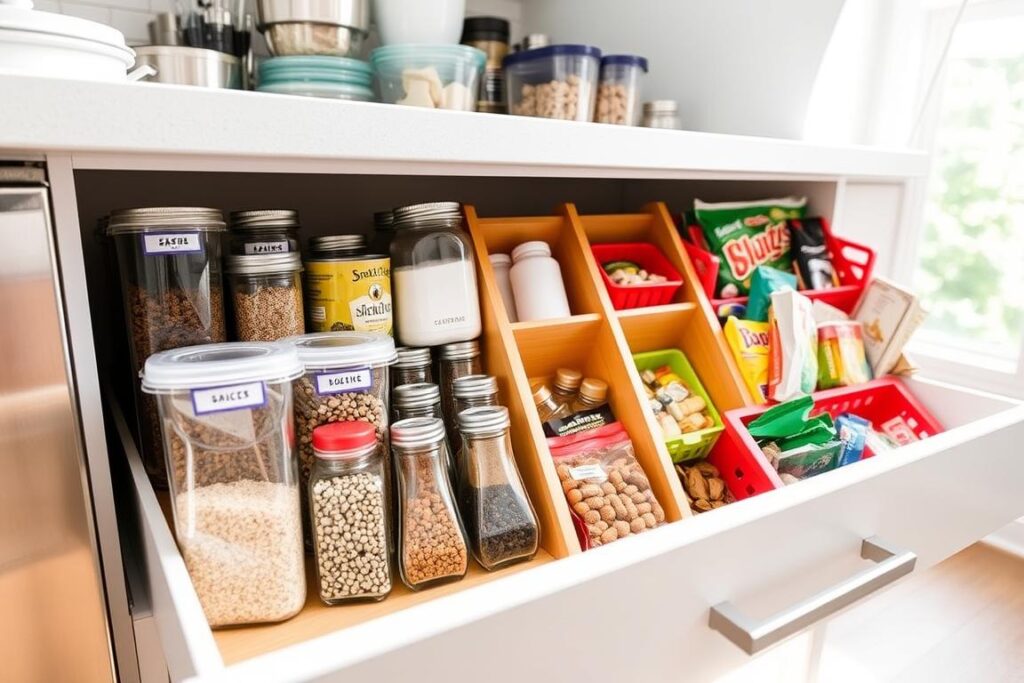
Utilize Vertical Space with Shelves and Racks
Use your kitchen’s vertical space with shelves and racks. Wall-mounted shelves are perfect for spices, oils, and vinegars. They keep these items within reach.
Over-the-door racks are great for cleaning supplies and trash bags. They save cabinet space. Pot racks are also smart for storing pots, pans, and lids. They keep these items accessible but out of the way.
“A place for everything, and everything in its place.”
Maximize Cabinet and Drawer Space with Dividers
Dividers are key for can organization in pantry and making the most of cabinet and drawer space. Adjustable dividers help organize baking sheets, cutting boards, and pot lids. They keep these items from getting disorganized.
Drawer dividers are ideal for utensils, flatware, and gadgets. They keep these items sorted and easy to find. This saves time and makes cooking and cleaning up less stressful.
Organize Your Pantry for Efficiency
An organized pantry is key to a well-functioning kitchen. A few simple strategies can transform your pantry into an efficient space. Start by grouping similar items together, like baking supplies, canned goods, and snacks.
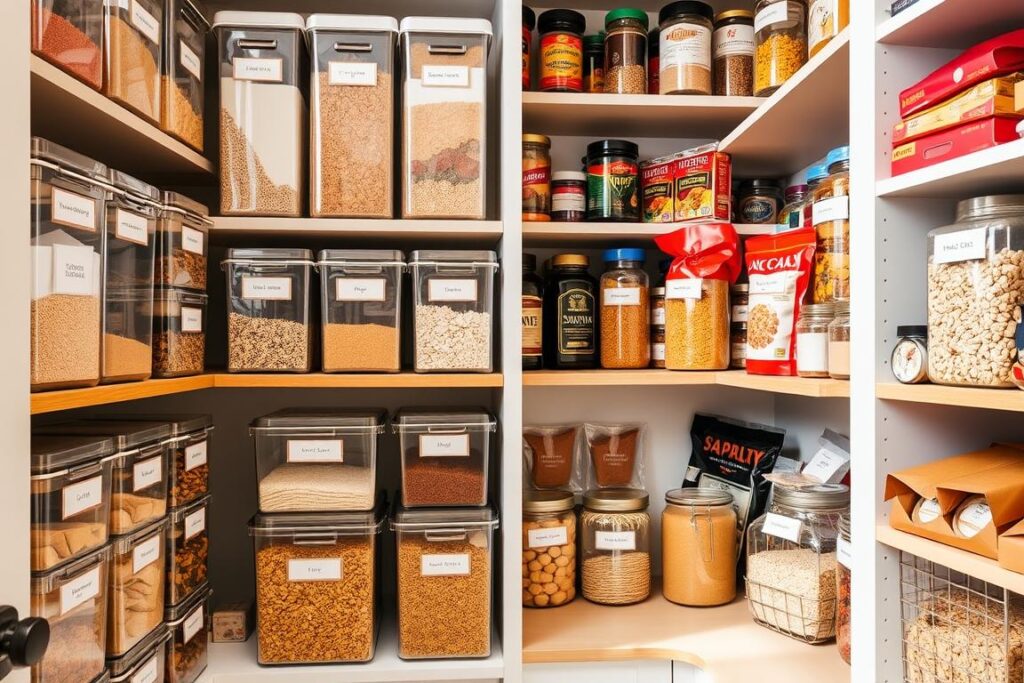
Invest in clear bins and labels for your pantry items. This makes it easy to find what you need quickly. Choose a labeling system that works for you, like handwritten or printed labels.
Implement a First-In, First-Out (FIFO) System
To reduce food waste, use a First-In, First-Out (FIFO) system. Place newer items towards the back and older items in the front. This trick keeps your pantry fresh and reduces expired products.
Group Similar Items Together
Organize your pantry by grouping similar items. This makes finding what you need easier and keeps your pantry tidy. Here’s how to group your pantry items:
| Category | Items |
|---|---|
| Baking Supplies | Flour, sugar, baking powder, baking soda, chocolate chips |
| Canned Goods | Soups, vegetables, fruits, beans, tomato sauce |
| Snacks | Chips, crackers, pretzels, granola bars, nuts |
| Grains and Pasta | Rice, quinoa, oats, spaghetti, macaroni |
Use Clear Bins and Labels for Easy Identification
For spice organization in your pantry, use uniform containers and labels. This makes spices easy to find and keeps your pantry neat. Store spices in a cool, dark place to keep their flavor and freshness.
A well-organized pantry is the foundation of a functional kitchen.
By following these simple strategies, you’ll have an organized pantry. This makes cooking and meal prep easier.
Streamline Your Kitchen Countertops
A clutter-free kitchen is key for an organized space. By organizing your countertops, you make cooking easier and more fun. This turns your kitchen into a place where you love to cook.
First, look at what’s on your countertops. Keep only what you use often, like appliances and utensils, within reach. Put away things you don’t use much. Use decorative trays or containers for small items like spices and oils.
Decide which items should stay on your countertops by asking yourself:
- Do I use this item every day?
- Does this appliance save me a lot of time and effort?
- Is this item pretty and does it make my kitchen look good?
Choosing wisely what you keep on your countertops makes your kitchen better. Here’s how a cluttered countertop compares to a streamlined one:
| Cluttered Countertop | Streamlined Countertop |
|---|---|
| Many small appliances | Only the essentials you use often |
| Utensils and gadgets all over | Utensils in containers or drawers |
| Too many spices | Spices in a special cabinet or drawer |
| Piles of mail and papers | Mail and papers somewhere else |
A clean and organized countertop is the foundation of a well-functioning kitchen.
By organizing your countertops, you make your kitchen more efficient and enjoyable. This supports your goal of a well-organized kitchen.
Create an Efficient Spice Storage System
Organizing your spices is key for a smooth kitchen. A few simple steps can make your pantry spice storage efficient. This saves time and makes cooking easier.
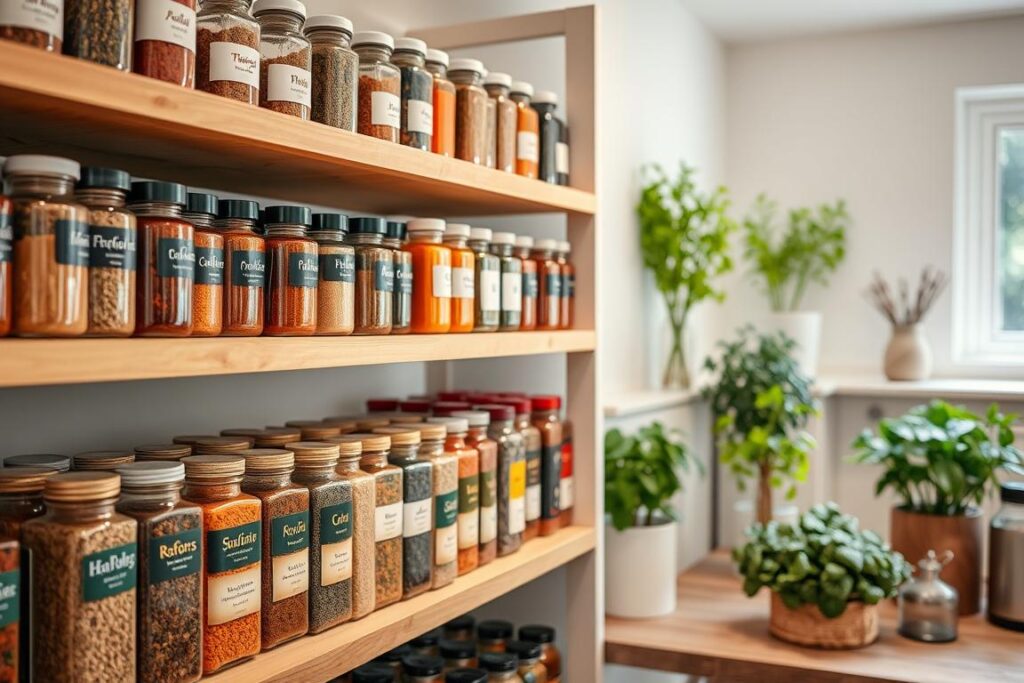
Start by putting your spices in uniform containers. This makes your pantry look neat and makes storing easier. Use airtight containers to keep spices fresh and dry.
Choose glass jars or clear plastic for easy viewing. This way, you can see what’s inside without opening the container.
Next, label your containers clearly. Use adhesive labels or a label maker for neat labels. Include the spice name and expiration date if you want. Clear labels help you find spices fast, saving time.
Store Spices in a Cool, Dark Place
Proper storage keeps spices fresh and flavorful. Store them in a cool, dark spot away from sunlight and heat. This prevents flavor and aroma loss.
A pantry or cupboard away from the stove is perfect. It keeps your spices in the best condition.
Use Uniform Containers and Labels
Organize spices in a way that suits your cooking. You can sort them alphabetically or by how often you use them. This makes finding spices quick and easy.
Another way is to group spices by cuisine or dish type. This helps when cooking specific meals. Organizing spices this way makes your kitchen more efficient and organized.
Follow these tips to create a better spice storage system. Your pantry will be clutter-free, and your kitchen will be more organized. Say hello to a more efficient cooking space!
Organize Your Kitchen Appliances and Tools
Keeping your kitchen appliances and tools organized is key for easy cooking. Smart storage and sorting by use can make your kitchen efficient and organized.
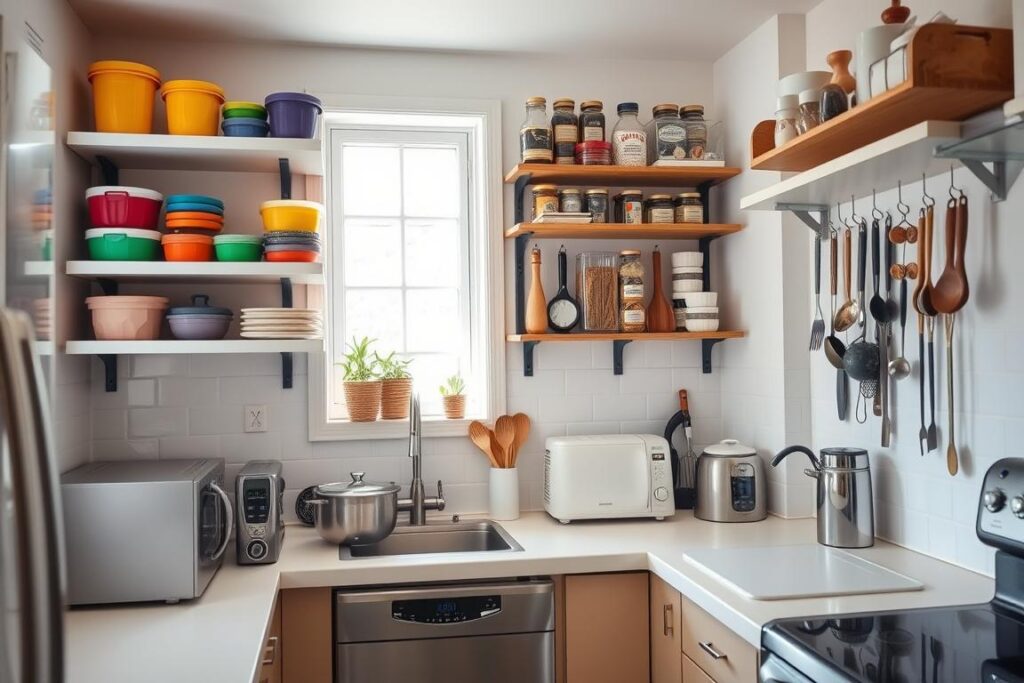
Keep Frequently Used Items Easily Accessible
To make cooking smoother, place your most-used tools and utensils where you can easily find them. Use a drawer or container near your work area for:
- Wooden spoons and spatulas
- Whisks
- Tongs
- Measuring cups and spoons
- Can opener
- Vegetable peeler
Having these essentials close by saves time and effort in meal prep.
Store Appliances Based on Frequency of Use
Not all appliances are used the same amount. Organize them by how often you use them. Here’s a guide:
| Frequency of Use | Appliances | Storage Location |
|---|---|---|
| Daily | Coffee maker, toaster, blender | Countertop or easily accessible cabinet |
| Weekly | Food processor, hand mixer, slow cooker | Lower cabinet or pantry shelf |
| Occasionally | Stand mixer, waffle iron, specialty appliances | Higher cabinet or less accessible storage area |
Storing appliances wisely saves counter and cabinet space. It keeps them accessible when needed. Good kitchen organization balances function and practicality.
A well-organized kitchen is the foundation of a happy cook.
Implement a Kitchen Cleaning and Maintenance Routine
Keeping your organized kitchen is more than just arranging things. It’s about regular cleaning and maintenance. By setting aside time each day, week, and month, your kitchen will stay in top shape.
Begin with a daily routine. This includes wiping down countertops, cleaning the sink, and putting away items. This stops clutter and makes your kitchen a nicer place to be. Here’s a simple daily cleaning checklist:
| Task | Frequency |
|---|---|
| Wipe down countertops and stovetop | After each use |
| Clean the sink and dishes | Daily |
| Sweep or vacuum the floor | Daily |
| Put away any stray items | Daily |
Weekly, do deeper tasks like cleaning the fridge, microwave, and mopping floors. These tasks take more time but keep your kitchen clean and fresh.
For monthly tasks, clean appliances and storage areas. This includes the oven, cabinet shelves, and pantry. Breaking these tasks into smaller parts makes it easier to keep your kitchen spotless.
The key to maintaining an organized kitchen is consistency. By making cleaning and decluttering a regular habit, you’ll find that your kitchen stays tidy with minimal effort.
Remember, kitchen organization is a team effort. Get your family involved by giving them tasks based on their age. With everyone’s help, your kitchen will stay clean and welcoming for years.
Involve Your Family in Maintaining Kitchen Organization
Keeping your kitchen organized is a team effort. Involving your whole family can make a big difference. By giving each family member tasks, you teach them to take care of the kitchen.
Assign Age-Appropriate Tasks to Family Members
Give tasks based on each family member’s age and skills. Young kids can put away dishes or wipe surfaces. Older kids and adults can organize the pantry or clean out drawers.
Create a Kitchen Organization Checklist
Make a checklist for kitchen tasks. It should have daily, weekly, and monthly jobs. Post it where everyone can see it to remind and motivate your family.
Schedule Regular Family Decluttering Sessions
Plan regular decluttering sessions for your family. Work together to get rid of unwanted items and organize spaces. This teaches teamwork and keeps your kitchen tidy.
FAQ
How can I make the most of my limited kitchen storage space?
To make the most of your kitchen space, use stackable containers for your pantry. Install shelves and racks to use vertical space. Add dividers in drawers and cabinets to keep things organized.
Clear bins and labels help you find items easily. This way, you can make the most of your space.
What’s the best way to declutter my kitchen?
Begin by taking stock of what you have in your kitchen. Identify areas that are cluttered. Be strict about getting rid of items you don’t need, like duplicates or broken things.
Donate items that are still good and throw away broken ones. This will help you declutter effectively.
How do I create an efficient kitchen organization plan?
First, divide your kitchen into zones based on what you do there. Sketch out a plan for each zone to see how it will work. List the tools you need for each zone, like containers and shelves.
What’s the best way to organize my pantry?
Organize your pantry by grouping similar items together. Use clear bins and labels to find things easily. Use a First-In, First-Out system to avoid food waste.
How can I keep my kitchen countertops clutter-free?
Only keep essential items on your countertops. Store less-used items in cabinets or drawers. Use trays or containers for small items.
Declutter and clean your countertops regularly. This keeps your kitchen looking neat and organized.
What’s the best way to store spices in my kitchen?
Put your spices in uniform containers and label them. Store them in a cool, dark place to keep their flavor. Organize them alphabetically or by how often you use them for easy access.
How can I involve my family in maintaining kitchen organization?
Give family members tasks that fit their age, like putting away dishes. Make a checklist for everyone to follow. Have regular family sessions to declutter and keep the kitchen tidy.
This helps everyone work together to keep the kitchen organized.
